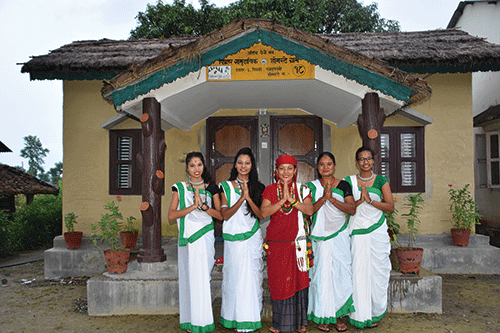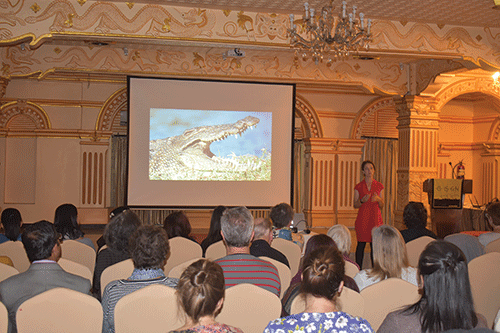 Even as we were about to start interviewing Prof. Dr K K Shrestha, a message was conveyed that a group of four students from UK had arrived. Dr Shrestha is Chairman of Tribhuvan University’s Botany Department and is supervising the group’s work on request of one Dr Will Douglas Tuladhar, an anthropologist who worked for several years in Nepal, and is currently living in UK.
Even as we were about to start interviewing Prof. Dr K K Shrestha, a message was conveyed that a group of four students from UK had arrived. Dr Shrestha is Chairman of Tribhuvan University’s Botany Department and is supervising the group’s work on request of one Dr Will Douglas Tuladhar, an anthropologist who worked for several years in Nepal, and is currently living in UK.
“Though Douglas is a native of Britain, he has been using the Nepali surname after he married a Nepali woman. He has been using the name in all his scientific and official work since,” says Shrestha. Douglas is the group’s supervisor in UK. The group includes two students of botany, one of anthropology and a journalist. They’ll spend two months in Rasuwa District researching on ethnic Tamang community’s dependence on plant resources and whether the resources are on the rise or decline.
Shrestha says, “Short term projects and programs involving Nepalese and foreign students are a regular feature. Some students from TU will also be engaged to study the way the plant resources are being utilized and roles they have played in supporting livelihoods of the Tamang community.”
Dr Shrestha is very particular about involving home grown botanists in such programs. Because Nepal is one among the 20 most important bio-diversity hot-spots, there are slew of projects and programs running all year round.
“The biggest fascination botanists from other countries have about Nepal’s flora is the amount of bio-diversity found within less than 200 kilometers from south to north. It is very rare to find such variation in vegetation and ecosystems in such a short range. Plants found in the lowland environment 60m above sea level are completely different from those that grow in an alpine environment above 4000m,” says Dr Shrestha.
“Most botanists abroad think that in Nepal, being a Himalayan country, each and every plant is a high altitude plant. And if you tell them about those in the Terai that grow at 60m above sea level, they will instantly say the plant must be from India.”
According to Dr Shrestha, rhododendron, Himalayan blue poppy, orchids and rose flowers from Nepal are highly popular in private and public gardens in European countries. “For high altitude plants like rhododendron and blue poppy they simulate an alpine environment to keep the plants from withering away during summers,” he says.
“In all botanical gardens they have an ‘alpine house’ where the temperature is
minus 15 to 20 degrees, a precondition for plants that grow above 4000m. Tropical house, likewise, has plants found in a tropical environment, and the moment you enter the house you will feel like taking your clothes off as it is too hot inside,” says Shrestha.
According to Dr Shrestha we have
required expertise and resources to create and maintain such facilities with simulated
environment in Nepal, too. What we don’t have, he says, is support and appreciation from government. “In foreign countries the government increases the salary of staff and the amount to be invested on projects every year. Here we don’t get a penny beyond our salary.”
“Plant technology is at a low stage of development in Nepal. Genetic technology and research are virtually non-existent,” says Shrestha, and adds, “Teachers and students from our department are currently helping farmers in mass propagation of high value national plants through the method of tissue culture.”
“If we get required support from the government for research and development we can achieve the level of technological advancement seen in developed countries in less than 20 years,” he says.
Until 1997 all projects related to plants research and development were single-handedly steered by the Department of Plant Resources. “But I, among others, played a key role,” he says, “in linking such activities to the Department of Botany, so that many of our botanists could benefit from international projects.” As a government institution, the Department of Plant Resources has limitations that the Botany Department does not have. The Botany Department is free to collaborate with other institutions, bring projects and decide modalities of execution by itself.
Dr K.K. Shrestha coordinated a project that was a part of the build up process to writing and publishing the book Flora of Nepal. The project called ‘Repatriation of Plant Information from Nepal’, funded by the ‘Darwin Initiative’ of the UK government, began in 1997. Dr Shrestha spent two years gathering information about Nepalese plants at the Natural History Museum (London), and was supported by four other botanists who took turns joining him as Darwin Scholars during the project.
Dr Shrestha’s interest in the project, apart from the main objective of preparing a
comprehensive record, was the engaging of Nepalese botanists.
“In the agreement for the project to record and publish Flora of Nepal we have a provision for shared authorship,” he says. This arrangement allows Nepali botanists to write it by themselves first, and only if help is required will foreigners assist them. We want our botanists to take as much credit as possible,” says Dr Shrestha.
But the government is not taking the efforts of botanists seriously, he implies. It has not been able to engage full time researchers on the project. Practically, it’s not possible for the botanists to continue their routine jobs and also work on the project with no added allowances or incentives.
Government must not forget that help from others is important, but not always reliable. “Only if our government understands this fact and supports them will Nepalese botanists be on an equal footing with foreign experts and get the credit for their work in the book Flora of Nepal,” says Dr Shrestha.
“If not, Nepalese botanists, too, will have to go through the unfortunate fate suffered by Bhutanese botanists. The book that profiled the flora of Bhutan was published
entirely by the experts from Royal Botanical Garden of Edinburgh. The book was
completed in 20 years and when it was published in 1983, it had no mention of Bhutanese experts as there were none,” says Dr Shrestha.
“But ours is a different case,” he adds. “The Bhutanese neither had resources nor a herbarium. We have botanists who are capable, a herbarium for collection and
research and we have resources. And that is why we want our botanists to get as much credit as possible.”
“We want to execute the work following the Chinese model,” Shrestha says. When they began profiling the flora of China they started with Chinese botanists who prepared all the profiles in Mandarin as far as they could. Later they collaborated with the Missouri Botanical Garden of the USA to translate and update the work, but they put a condition that when the final version of the book was published the first author would be a Chinese. Or, if the book is published in parts, every volume will have a Chinese as the first author, while the rest could be from any country.
The second project under the Darwin Initiative began in 2000. The partner organization, this time, was the Royal Botanical Garden of Edinburgh and it collaborated with three Nepalese institutes which included the Nepal Academy of Science and Technology, the Department of Plant Resources and the Botany Department of Tribhuvan University. In order to build capacity for identifying, locating and describing plant species, 16 Nepalese botanists underwent three years of training under the programs funded by the Initiative. The botanists were given extensive field training in Nepal on how to collect and record specimens and two weeks of field training at the three botanical gardens in the UK: the Kew Garden, the Natural History Museum (London) and the garden at Edinburgh to study the specimens collected from Nepal.
These 16 botanists are now the potential candidates for writing Flora of Nepal, but they are in a state of limbo as government has not taken any initiative to support them. These people who have received three years of invaluable training are, until now, working on the project without any incentives.
“Though the project is moving in fits and starts, we are pushing ahead with the task of coming out with at least one volume by the end of 2008,” says Dr Shrestha. He is happy, nonetheless, for the fact that whenever the book will be published it will have some Nepalese names along with the names of experts from the UK or Japan.

Liquid Gold: Nepal's Beer Industry Is Growing And Changing Fast
One need only glance at the beer section of the local liquor store to see that...










